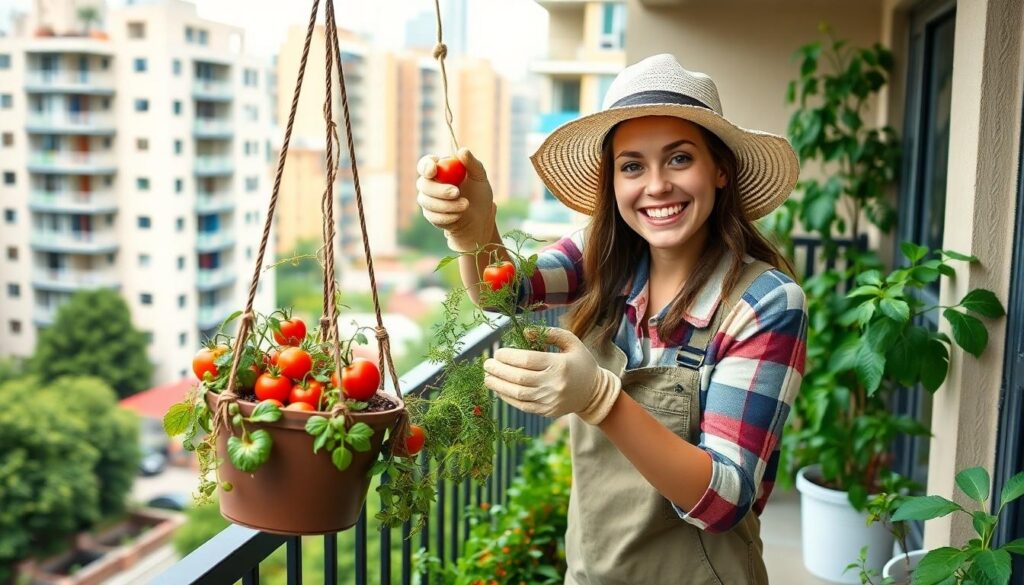Looking for a space-saving way to grow juicy tomatoes? Upside down tomato planting might be just what you need! This innovative gardening technique allows you to grow tomatoes vertically by suspending them from containers, making it perfect for small patios, balconies, or any area with limited garden space.
Why Upside Down Tomato Planting Is Revolutionizing Home Gardening
Upside down tomato planting has truly transformed how home gardeners approach growing their favorite fruits. This innovative technique offers multiple advantages that traditional in-ground gardening simply can’t match. Let’s explore why so many gardeners are turning their tomato plants upside down.
Space-Saving Magic
Vertical gardening answers like upside down tomatoes maximize every inch of available space. Urban dwellers with tiny balconies can now grow prolific tomato plants without sacrificing precious floor space. Hanging planters use overhead areas that would otherwise remain empty, effectively doubling your growing capacity. Apartment gardeners particularly benefit from this approach, as they can suspend several plants from railings or sturdy hooks without needing ground soil at all.
Reduced Pest Problems
Growing tomatoes upside down naturally elevates plants away from common soil-dwelling pests. Cutworms, slugs, and many beetles that typically damage tomato plants can’t easily reach suspended containers. Fungal diseases that splash up from soil during rainstorms are also dramatically reduced. Many gardeners report up to 80% fewer pest issues when using this method compared to traditional gardening. Natural barriers created by the hanging position deter even persistent pests like tomato hornworms.
Improved Air Circulation
Suspended tomato plants enjoy superior airflow around their foliage and fruits. Air circulates freely around hanging plants, reducing humidity that can lead to fungal problems. Leaves dry faster after morning dew or rainfall, preventing conditions favorable for blight development. This natural ventilation system creates a healthier growing environment without any additional effort. Plants with good air circulation typically develop stronger stems and more resilient immune systems.
No Staking Required
Traditional tomato plants demand complex cage or stake systems for support. Upside down planting eliminates this requirement completely as gravity naturally pulls stems downward. The plant’s energy can focus on producing fruit rather than building stronger stems to fight gravity. Gardeners save both money and time that would otherwise be spent on purchasing and installing support structures. This simplified approach makes tomato growing more accessible for beginners and those with physical limitations.
Easier Harvesting
Picking tomatoes becomes remarkably straightforward with upside down containers. Ripe fruits hang at eye level or slightly below, making them easy to spot and reach. Gardeners no longer need to bend down or kneel in soil to search for hidden tomatoes. This accessibility transforms the harvesting experience, especially for those with back problems or limited mobility. Weekly harvests typically take half the time compared to traditional garden beds.
7 Surprising Benefits of Growing Tomatoes Upside Down
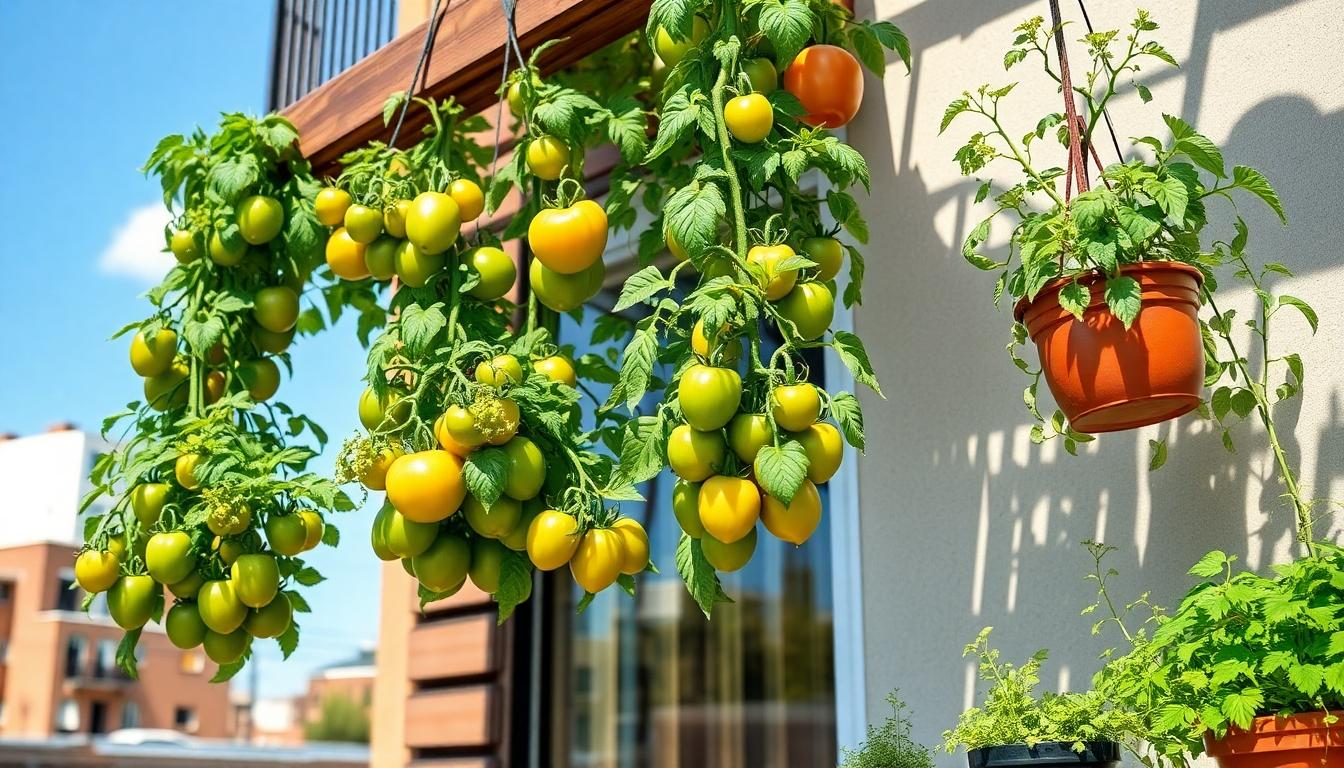
1. Space-Saving Advantages for Small Gardens
Upside down tomato planting offers exceptional space-saving benefits for gardeners with limited room. This innovative method frees up valuable ground space in small gardens, balconies, and patios while still allowing you to grow delicious tomatoes. You’ll appreciate the flexibility of being able to move your hanging plants as needed to maximize your limited gardening area. Many urban gardeners find this approach particularly valuable as it transforms unused vertical space into productive growing areas, effectively doubling their gardening capacity without expanding their footprint.
2. Reduced Pest and Disease Problems
Growing tomatoes upside down significantly reduces pest and disease issues that commonly plague traditional gardens. By suspending plants above ground, you’ll minimize contact with soil-borne pathogens that can devastate tomato crops. Your plants will remain safer from ground worms and other crawling pests that typically access plants from the soil. This natural form of pest management decreases the need for chemical interventions, resulting in healthier produce and a more environmentally friendly garden network.
3. Better Sun Exposure for Optimal Growth
Upside down tomato plants enjoy superior sun exposure compared to their ground-planted counterparts. We can easily reposition hanging planters throughout the day to follow the sun’s path, ensuring plants receive maximum photosynthesis time. This mobility also provides critical protection during extreme weather events, as planters can be temporarily moved to sheltered locations. The ability to optimize sunlight exposure regardless of your garden’s fixed orientation leads to healthier plants, faster growth rates, and eventually more abundant harvests.
4. No Need for Staking
Upside down tomato growing eliminates the tedious task of staking that traditional tomato gardening requires. Plants naturally vine outward and downward without any support structures, saving you time and materials. This staking-free approach prevents the stem damage that often occurs when securing plants to supports. Gardeners with mobility issues find this benefit particularly valuable, as it removes the physical demands of installing and maintaining stakes throughout the growing season.
5. Reduced Labor
The upside down method dramatically reduces overall gardening labor requirements throughout the season. Trellising becomes completely unnecessary, saving hours of installation and maintenance work. Plant handling decreases significantly, which lowers the risk of virus transmission that can occur through human contact. Many gardeners report spending up to 70% less time maintaining upside down tomato plants compared to traditional in-ground varieties while achieving comparable or better yields.
6. Sustainability Benefits
Upside down tomato growing offers impressive sustainability advantages for environmentally conscious gardeners. The absence of trellising materials like plastic wires reduces your garden’s overall carbon footprint. End-of-season cleanup produces cleaner composting material without the plastic contamination common in traditional tomato growing methods. Water efficiency improves with this technique as well, with many systems incorporating built-in reservoirs that minimize waste and maximize absorption by the plants.
7. Improved Air Circulation
The hanging position of upside down tomatoes creates superior air circulation around all parts of the plant. This enhanced airflow helps prevent the development of fungal diseases like early blight and powdery mildew that thrive in stagnant, humid conditions. Your plants’ leaves will dry more quickly after rain or watering, further reducing disease pressure. The improved ventilation also helps maintain optimal growing temperatures around the fruit, potentially improving both yield and flavor of your homegrown tomatoes.
How to Create Your First Upside Down Tomato Planter
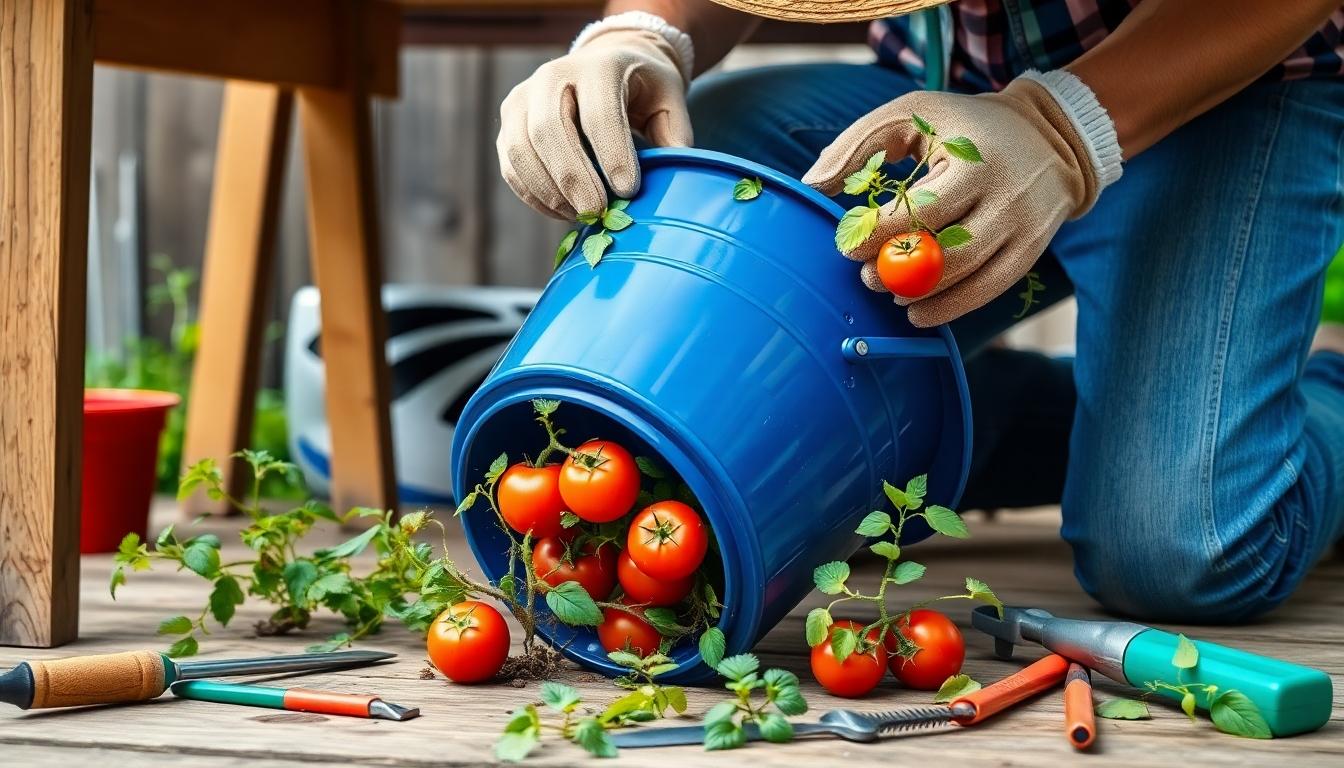
Creating your first upside down tomato planter is simpler than you might think. We’ve broken down the process into three easy sections to help you get started with this space-saving gardening technique.
Materials You’ll Need for Success
Before diving into construction, gather these essential supplies for your upside down tomato planter:
- 5-gallon bucket or similar sized container
- Drill with 2-3 inch drill bits
- Fabric or mesh material for soil retention
- Healthy tomato seedling
- Quality potting soil
- Peat moss for moisture retention
- Perlite to keep the soil mixture light
- Mycorrhizal fungi (optional but beneficial for root health)
- Strong hook or hanger that can support the weight
- Optional soil amendments to enhance growth
The 5-gallon bucket is particularly important as it provides adequate space for root development while remaining manageable in weight when hung. Select materials that are durable enough to withstand outdoor conditions throughout the growing season.
Step-by-Step Construction Guide
- Drill the Hole: Create a 2-3 inch hole in the center of the bucket’s bottom, which will serve as both the planting hole and drainage point.
- Prepare the Fabric: Cut a piece of fabric slightly larger than the bottom of your bucket, then make a slit in the center where your tomato plant will go through.
- Position the Fabric: Lay the fabric inside the bottom of the bucket with the slit aligned with the drilled hole to prevent soil from falling out.
- Insert the Tomato Seedling: Carefully thread your tomato plant through the hole from inside the bucket, positioning it so the root ball remains inside while the stem and leaves hang below.
- Add Soil: Fill the bucket with a 2:2:1 mixture of potting soil, peat moss, and perlite, gently packing it around the plant’s roots without compacting too firmly.
- Hanging and Care: Secure your planter in a location that receives adequate sunlight, then water thoroughly until moisture drips from the bottom opening.
Adding mycorrhizal fungi to the soil can significantly enhance root development and overall plant health in this unique growing environment.
Choosing the Right Container Types
When selecting containers for upside down tomato planting, consider these popular options:
- 5-Gallon Buckets: The most widely recommended option due to their ideal size, outstanding durability, and affordable price point. Food-grade buckets work especially well if you’re growing edibles.
- Commercial Hanging Planters: These purpose-built containers often feature more attractive designs and may include built-in watering systems for convenience.
- Recycled Containers: With proper modification, many household items can be repurposed into upside down planters, though ensure they’re strong enough to support a fully grown tomato plant.
The container you select should balance adequate space for root development with practical considerations like weight and hanging capabilities. Whichever option you choose, ensure it has proper drainage and can be securely hung to support the increasing weight as your tomato plant grows and produces fruit.
Selecting the Best Tomato Varieties for Upside Down Growing
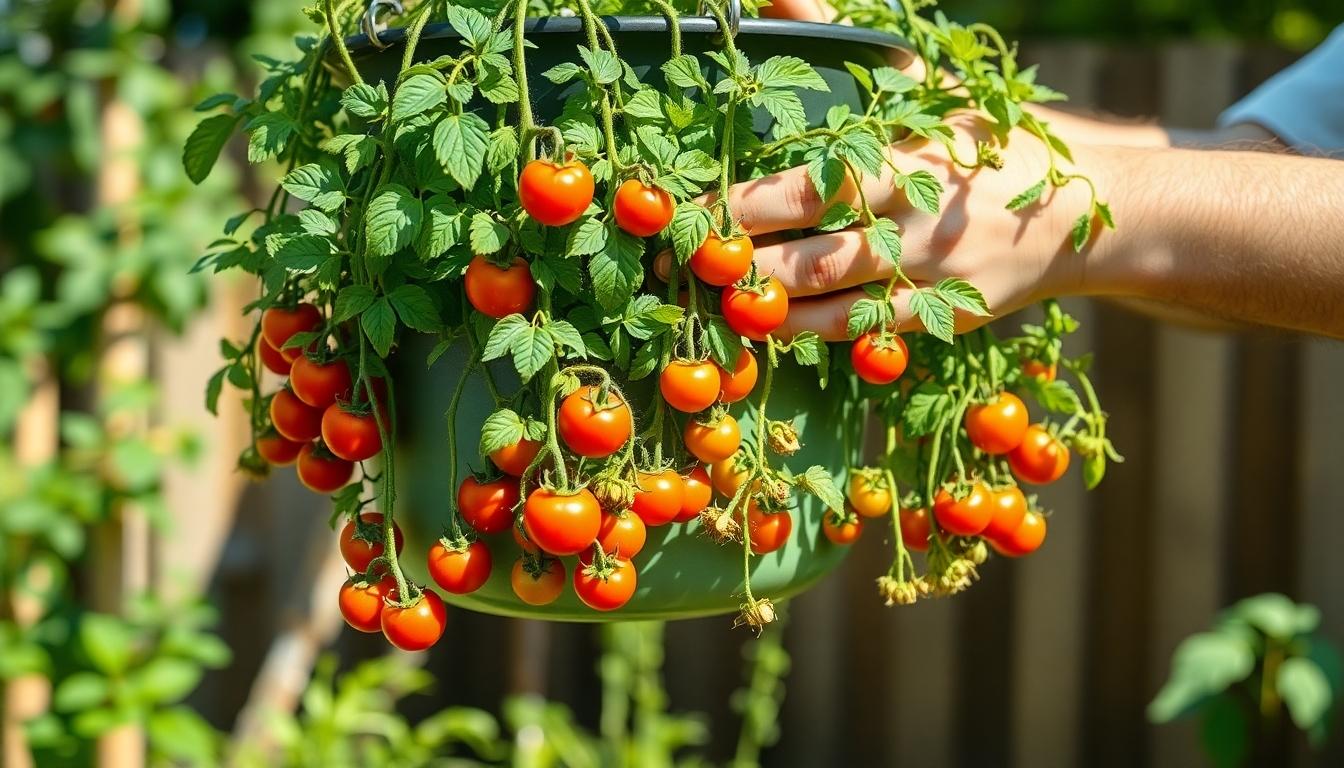
Choosing the right tomato varieties is crucial for upside down gardening success. Not all tomatoes perform equally well in hanging planters, and selecting appropriate cultivars can make the difference between a bountiful harvest and disappointing results.
Determinate vs. Indeterminate Varieties
Determinate varieties stand out as excellent choices for upside down planters due to their compact growth habit. These bush-type tomatoes like ‘Roma’ and ‘Celebrity’ naturally grow to a predetermined size, making them ideal for confined spaces. Their self-limiting growth pattern prevents the excessive vine development that can overwhelm hanging containers. Indeterminate varieties such as ‘Cherry’ and ‘Sweet Million’ can also work in upside down systems but require frequent maintenance. These vining tomatoes will continue growing throughout the season, necessitating regular pruning to manage their vigorous growth habits. Without proper pruning, indeterminate types can become too heavy for the planter’s support structure and may develop nutrient deficiencies as they struggle to deliver resources to distant vine tips.
Size Considerations for Successful Harvests
Plant size directly impacts your upside down growing success. Varieties that remain under 3-4 feet tall are optimal choices as they prevent excess root stress and ensure nutrients can effectively reach all parts of the plant. Shorter plants maintain better balance within hanging planters and are less likely to become top-heavy. Fruit weight should factor into your variety selection process. Smaller-fruited cultivars like cherry and grape tomatoes put significantly less strain on hanging structures compared to large beefsteak types that can weigh down and potentially damage your planter system. Root capacity demands adequate planning for container size. Your upside down planters should hold between 5-10 gallons of soil to support healthy root development and maintain consistent moisture levels throughout the growing season. This volume provides sufficient space for roots to expand while holding enough soil to buffer against rapid temperature changes and dehydration that smaller containers might experience.
Essential Care Tips for Upside Down Tomato Plants
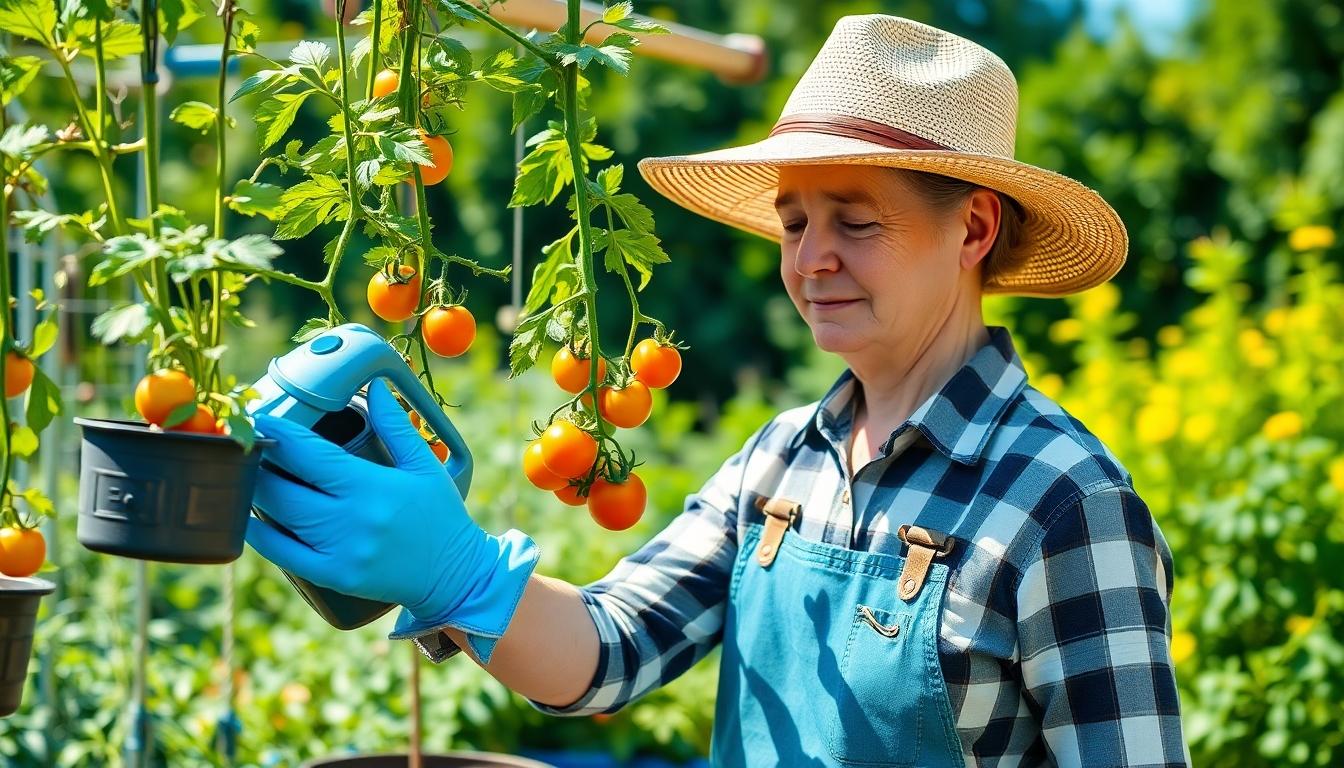
Watering Techniques for Inverted Containers
Proper watering is crucial for upside down tomato plants to thrive. Always water in the morning to allow foliage time to dry completely, which significantly reduces the risk of fungal diseases caused by water dripping onto the plant. We recommend using a lightweight potting mix with a ratio of 2 parts soil, 2 parts peat moss, and 1 part perlite to improve drainage and reduce the overall weight of your container. This specialized soil mixture helps maintain consistent moisture without becoming waterlogged. Avoid overwatering your upside down tomatoes as soggy soil can quickly suffocate the roots and lead to root rot. Check soil moisture regularly by inserting your finger about an inch into the soil – if it feels dry at that depth, it’s time to water.
Fertilizing Schedule for Maximum Yields
Feeding your upside down tomatoes properly ensures abundant harvests throughout the growing season. Start by incorporating a balanced fertilizer directly into your potting soil at planting time to provide essential nutrients from day one. We suggest supplementing with a water-soluble, tomato-exact fertilizer every 2-3 weeks during the fruiting period for optimal results. Follow the label instructions carefully to avoid over-fertilization, which can burn roots and reduce yields. Tomatoes growing in suspended containers typically require more frequent fertilization than ground-planted varieties because nutrients leach out more quickly with regular watering. Adjust your feeding schedule based on plant appearance – pale leaves often indicate a need for additional nitrogen, while poor fruit production might signal a phosphorus deficiency.
Pruning Strategies for Healthy Growth
Strategic pruning helps direct energy toward fruit production in upside down tomato plants. Remove suckers (the small shoots that develop between the main stem and branches) promptly to prevent the plant from wasting energy on excessive foliage growth. Trim any yellowed or diseased leaves immediately to improve air circulation and reduce disease pressure throughout the plant. Maintain a balance when pruning – avoid heavy cutting as this creates stress on inverted plants that already face the challenge of growing against gravity. Focus pruning efforts on maintaining an open plant structure that allows light to reach developing fruits while preserving enough foliage to support photosynthesis. Position your containers in filtered sunlight rather than full, direct sun to prevent soil dehydration and leaf scorch which commonly affects hanging plants. Select disease-resistant cultivars like Super Sweet 100 or Cherry Bomb for their resilience against the particular challenges of upside down growing, especially issues related to foliage wetting. Secure your buckets with reinforced handles to support the increasing weight as your plants mature, ensuring they remain safely suspended throughout the growing season.
Common Mistakes to Avoid When Growing Tomatoes Upside Down
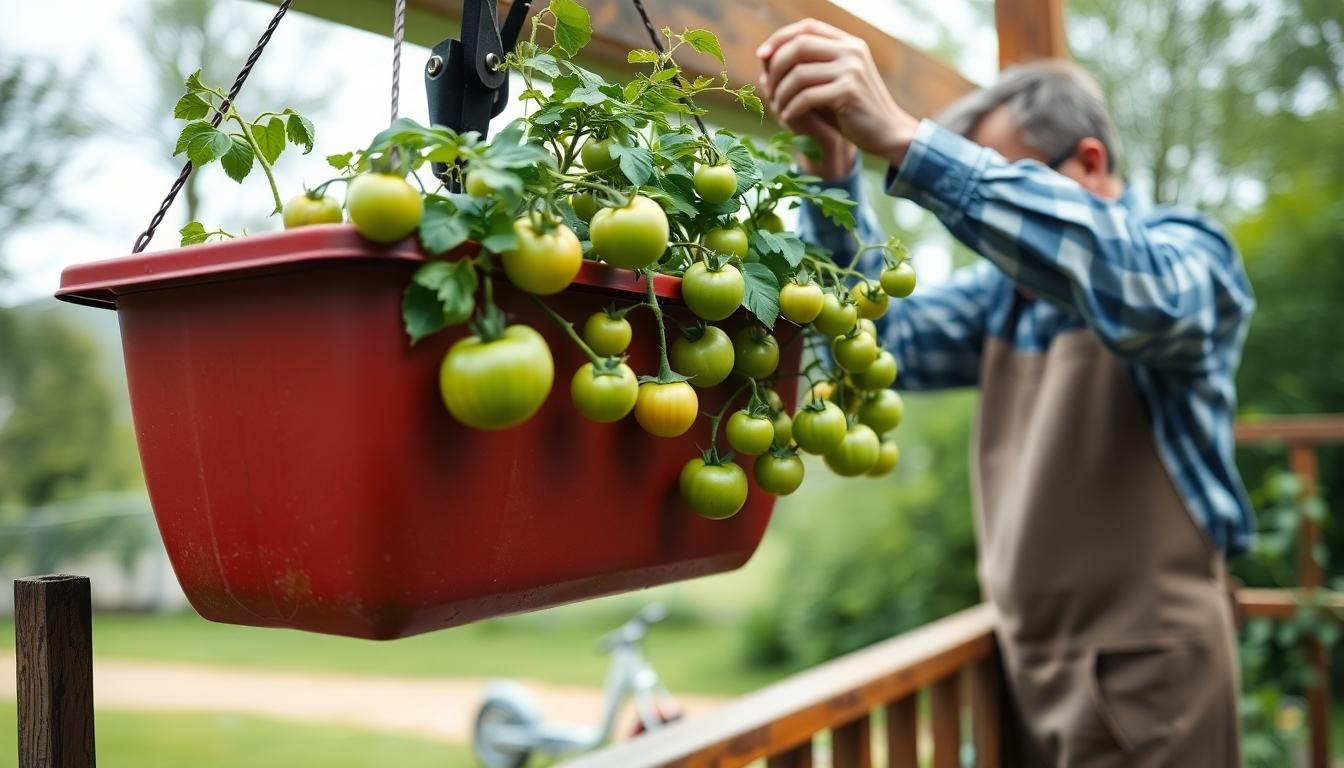
Growing tomatoes upside down offers many advantages, but success depends on avoiding some common pitfalls. We’ve identified five critical mistakes that can compromise your upside-down tomato growing experience:
- Insufficient Soil Support
Soil falling out when you invert your planter is a frustrating and common issue for beginners. This typically happens when there’s nothing to hold the soil in place as you flip the container. Many experienced gardeners solve this problem by placing layers of paper towels or fabric across the bottom hole before adding soil. The material creates a barrier that keeps soil contained while still allowing the plant to grow through.
- Incorrect Hole Size
The entry hole for your tomato plant requires careful consideration. Drilling a hole that’s too small (under 2 inches) can restrict root growth and damage the stem as the plant matures. Conversely, holes that are too large allow soil to escape and don’t provide adequate support for the developing plant. A 2-inch diameter hole typically provides the ideal balance between support and growth space for most tomato varieties.
- Premature Inversion
Flipping your planter too soon after planting is a mistake that can lead to the entire plant falling out. Patience pays off with upside-down planting. Waiting 10-14 days after initial planting allows the tomato roots to establish and secure themselves in the soil, creating a natural anchor that keeps everything in place when inverted.
- Poor Watering and Drainage
Drainage issues can quickly kill upside-down tomato plants. Water that can’t escape leads to root rot and other moisture-related problems. Using a lightweight soil mix that includes perlite improves drainage significantly. Regular checks to ensure drainage holes remain clear from soil blockage help maintain proper moisture levels throughout the growing season.
- Inadequate Sunlight Exposure
Tomato plants require substantial sunlight to produce fruit, but many gardeners place their upside-down planters in locations that receive insufficient light. Although one advantage of hanging planters is mobility, failing to position them where they receive at least 6-8 hours of daily sunlight will significantly reduce your harvest. Moving planters to follow the sun’s path throughout the day can maximize exposure and increase productivity.
By avoiding these common mistakes, we can enjoy all the benefits of upside-down tomato gardening while producing healthy plants and bountiful harvests. This space-saving technique becomes even more rewarding when implemented with the proper knowledge and preparation.
Creative Upside Down Tomato Garden Design Ideas
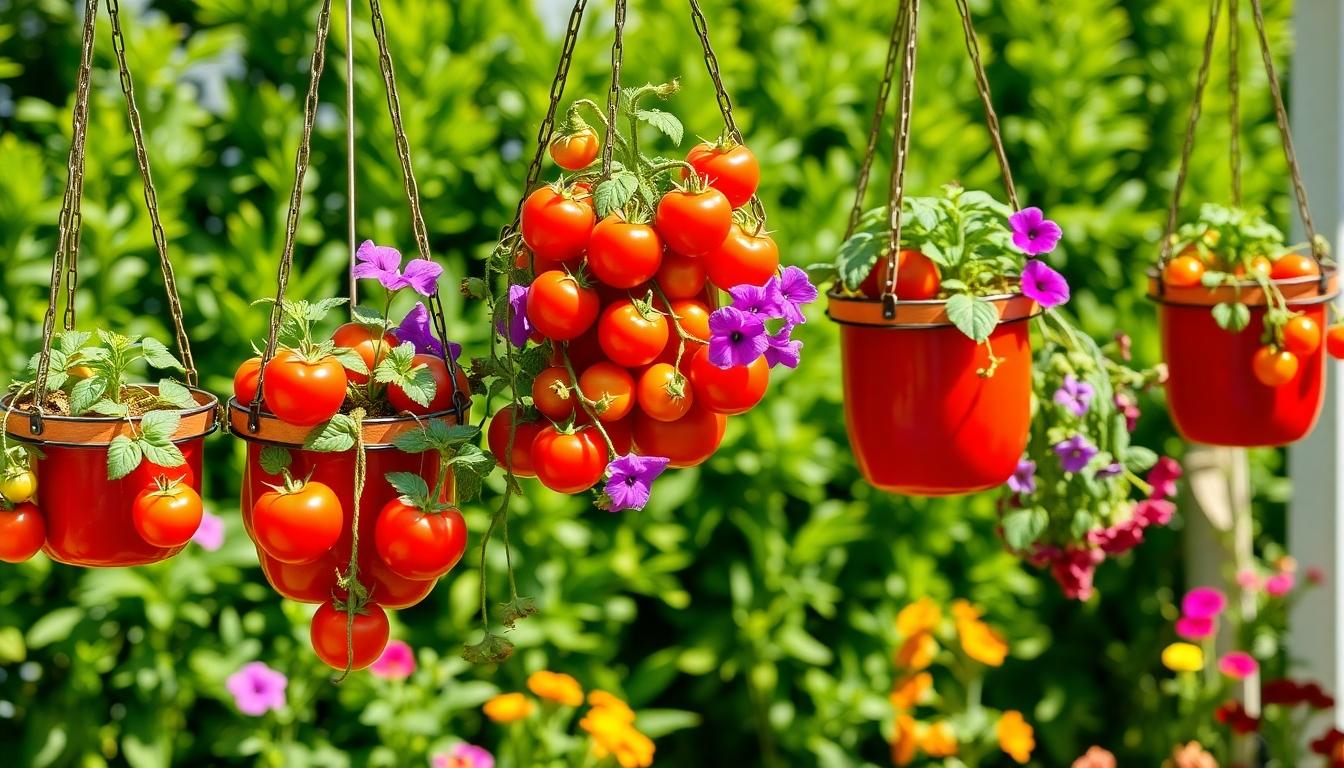
Upside down tomato planting offers endless possibilities for creating unique and eye-catching garden displays. These innovative growing systems can transform ordinary spaces into extraordinary showcases of creativity and productivity.
Combining Multiple Plants in Vertical Gardens
Vertical gardens with upside down tomatoes can incorporate a variety of companion plants to maximize both space and yield. Herbs like basil, oregano, and thyme thrive when planted in the top portion of tomato planters, creating a practical two-tier growing system. These complementary plantings not only look attractive but also offer practical benefits, as many herbs naturally repel insects that might otherwise damage your tomatoes. For small spaces, consider adding trailing plants like nasturtiums or petunias alongside your tomatoes to create cascading displays of color and texture. Multi-tiered hanging systems allow you to group several upside down planters together, creating a verdant wall of productive plants that transforms bare spaces into lush garden features.
Decorative Approaches for Front Yards and Patios
Stylish planters dramatically enhance the visual impact of upside down tomato gardens in visible areas like front yards and patios. Recycled containers, from painted coffee cans to repurposed buckets with decorative wraps, offer eco-friendly alternatives to store-bought planters while adding personality to your garden space. Artistic hanging mechanisms, such as decorative chains, macramé holders, or ornamental brackets, elevate the appearance of your tomato planters from purely functional to genuinely decorative. String lights woven around support structures create a magical evening ambiance while highlighting your productive plants after dark. Garden-themed decorations placed strategically around your upside down tomato display help integrate it into your overall industry design, creating a cohesive outdoor living space. Clustering several upside down planters at varying heights creates dimension and visual interest, transforming them from individual plants into a striking garden feature that serves as both food source and focal point.
Troubleshooting Problems With Your Upside Down Tomato Plants
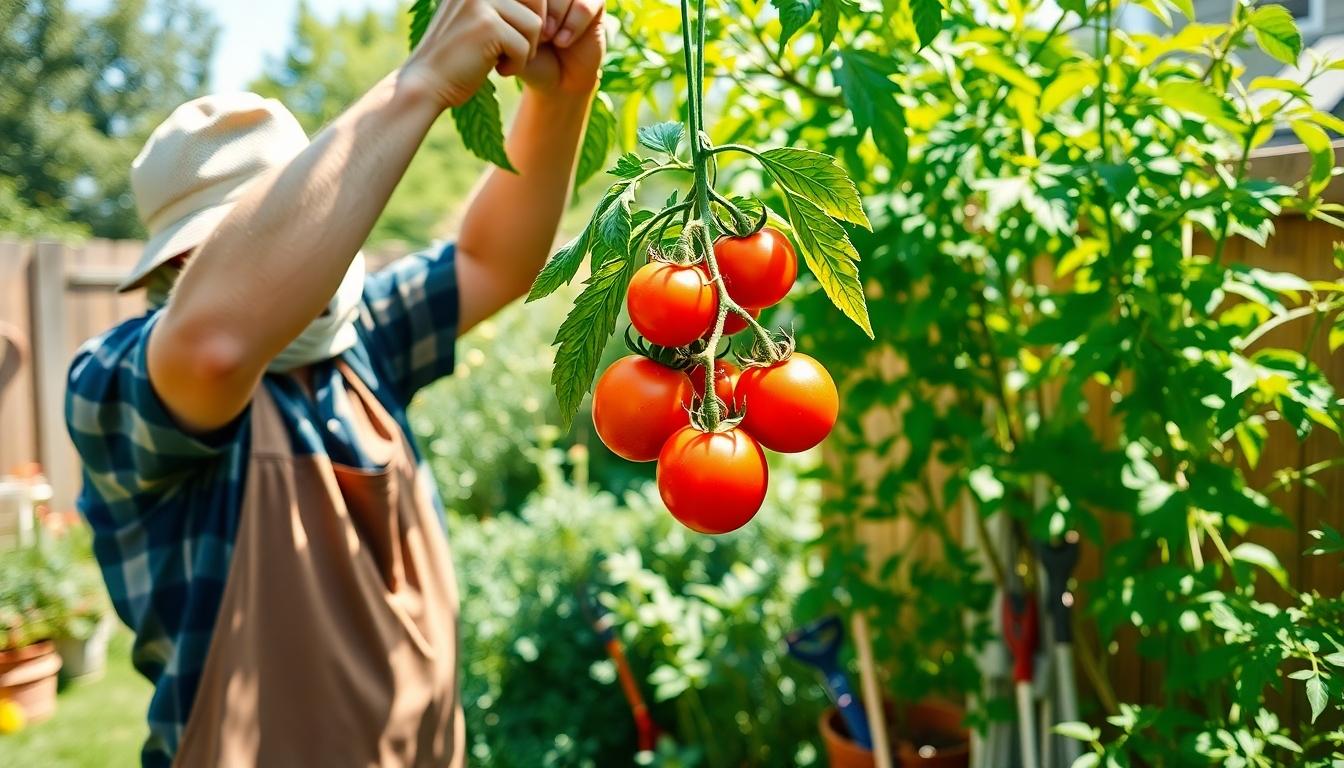
Even with careful planning, upside down tomato plants can develop issues that need attention. Identifying and addressing these common problems quickly will help ensure your hanging garden thrives. Let’s explore the main challenges you might face and how to overcome them.
Insufficient Support Structure
Support failures present a major risk to your upside down garden. The fully grown plant with soil and water can weigh significantly more than expected. To resolve this issue:
- Install heavy-duty hooks or brackets that can support at least 40 pounds
- Check support beams regularly for signs of stress or bending
- Consider distributing weight across multiple support points rather than a single hook
- Add reinforcement to existing structures if you notice any sagging
Watering Difficulties
Upside down tomato plants typically dry out faster than traditional gardens due to gravity and increased air exposure. Managing moisture effectively requires:
- Monitoring soil moisture daily, especially during hot weather
- Installing a simple drip irrigation system for consistent watering
- Adding water-retaining polymers to your soil mix to improve moisture retention
- Creating a watering schedule that accounts for seasonal changes in temperature
Nutrient Deficiency Issues
The limited soil volume in upside down planters can lead to faster nutrient depletion. Signs include yellowing leaves and poor fruit development. Address this by:
- Fertilizing more frequently than you would in-ground plants
- Using a balanced, slow-release fertilizer specifically formulated for container vegetables
- Supplementing with liquid fertilizer every 2-3 weeks during the growing season
- Paying attention to calcium levels to prevent blossom end rot
Pest Management Challenges
While upside down planting reduces soil-borne pests, airborne insects can still cause problems. Our recommended approach includes:
- Inspecting the undersides of leaves weekly for aphids and whiteflies
- Using insecticidal soap for mild infestations
- Introducing beneficial insects like ladybugs for natural pest control
- Placing yellow sticky traps nearby to monitor and reduce flying pest populations
By addressing these common issues proactively, you’ll maximize your chances of growing healthy, productive upside down tomato plants. Regular monitoring and quick intervention are key to enjoying the full benefits of this space-saving growing method.
Harvesting and Enjoying Your Upside Down Tomato Success
Upside down tomato planting offers a revolutionary approach to growing this beloved fruit. We’ve seen how this technique transforms small spaces into productive growing environments while reducing common gardening challenges.
By implementing the tips and avoiding the mistakes we’ve discussed, you’ll be well on your way to enjoying a bountiful tomato harvest without the traditional garden space requirements. The versatility of upside down planters allows for creative expression while delivering practical benefits.
Whether you’re an urban dweller with limited outdoor space or simply looking to try something new, upside down tomato growing delivers impressive results. Give this innovative method a try this growing season – you’ll likely find yourself wondering why you didn’t start sooner as you pluck ripe, juicy tomatoes from your suspended garden.
Frequently Asked Questions
What is upside down tomato planting?
Upside down tomato planting is a space-saving gardening technique where tomato plants grow vertically downward from suspended containers. This method allows you to grow tomatoes without using garden space, making it perfect for patios, balconies, and small yards. The plants hang from containers with the roots at the top and stems growing downward.
What are the main benefits of growing tomatoes upside down?
The key benefits include significant space savings, reduced pest and disease problems, improved sun exposure, elimination of staking needs, better air circulation, easier harvesting, and sustainability. This method requires less water, prevents soil-borne diseases, and makes tomatoes more accessible at harvest time without bending or kneeling.
What materials do I need to create an upside down tomato planter?
You’ll need a sturdy container (5-gallon bucket works well), a drill with bits, a utility knife, landscape fabric, potting soil, tomato seedlings, hanging hardware, and optional companion plant seeds. Most materials can be found at home improvement stores or repurposed from household items for an eco-friendly approach.
Which tomato varieties work best for upside down planting?
Compact determinate varieties and cherry tomatoes perform best in upside down planters. Good choices include Roma, Tiny Tim, Tumbling Tom, Patio Princess, and Sun Gold. Avoid large-fruited indeterminate varieties like Beefsteak as they can become too heavy and stress the container.
How should I water upside down tomato plants?
Water slowly and thoroughly from the top of the container, allowing moisture to seep through the soil to reach the roots. Check soil moisture daily, especially during hot weather. Upside down planters typically require more frequent watering than in-ground plants as they dry out faster due to increased exposure.
Do upside down tomatoes need fertilizer?
Yes, upside down tomatoes need regular fertilization since nutrients leach out faster with frequent watering. Apply a balanced, water-soluble fertilizer every 1-2 weeks at half strength. Alternatively, mix slow-release fertilizer into the soil at planting time and supplement with compost tea throughout the growing season.
How do I prevent my plants from falling out of the container?
Create an appropriately sized hole (2-3 inches) for the stem, secure the seedling with landscape fabric around the stem, and add soil gradually while holding the plant in place. Wait until your seedling is well-established with a strong root system before hanging it upside down to ensure it stays securely in the container.
Can I grow other plants alongside upside down tomatoes?
Yes! The top of the container is perfect for growing shallow-rooted companion plants like basil, chives, marigolds, or lettuce. This creates a productive two-tier garden system. Just ensure top plants don’t require significantly different care than your tomatoes and won’t compete excessively for nutrients.
How do I troubleshoot yellowing leaves on my upside down tomato plants?
Yellowing leaves often indicate watering issues or nutrient deficiencies. Check soil moisture consistency, ensure adequate drainage, and increase fertilization frequency. Also verify your plants receive 6-8 hours of direct sunlight daily. Upside down plants may need more frequent feeding than traditional garden plants due to more rapid nutrient leaching.
Is it possible to make upside down tomato planters look attractive?
Absolutely! Paint containers with non-toxic, weather-resistant paint, group planters at varying heights for visual interest, or incorporate decorative elements like colorful ribbons. You can also use attractive hanging baskets instead of buckets or integrate them into a vertical garden wall design for enhanced aesthetic appeal.

